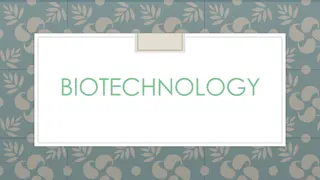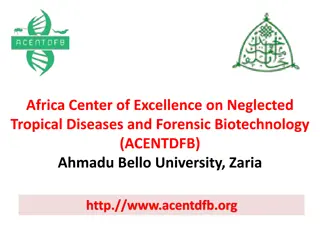Exploring Genetics and Biotechnology Concepts
This educational content delves into various genetics and biotechnology concepts, including genotypes, DNA segments, heredity, flower color inheritance, genetic crosses, and biotechnology processes. It clarifies terms like homozygous, heterozygous, dominant alleles, DNA components, and parental traits inheritance probabilities. The content covers essential topics for understanding genetic principles and applications in biotechnology.
Download Presentation

Please find below an Image/Link to download the presentation.
The content on the website is provided AS IS for your information and personal use only. It may not be sold, licensed, or shared on other websites without obtaining consent from the author. Download presentation by click this link. If you encounter any issues during the download, it is possible that the publisher has removed the file from their server.
E N D
Presentation Transcript
Genetics and Biotechnology
The combination Tt represents a ________ genotype. A. purebred B. homozygous C. heterozygous D. recessive
A segment of DNA which controls a trait is a A. cell B. chromosome C. phosphate group D. gene
The process of an organism passing on its traits to its offspring is called A. phenotype B. heredity C. Punnett Square D. pedigree
Robert crossbreeds two plants, one with red flowers and one with white flowers. He discovers the offspring plants produce red flowers. Robert determines that A. The red flower allele is dominant B. The red flower shows incomplete dominance C. The white flower allele is dominant D. The white flower shows incomplete dominance
Pete crossbreeds two plants, one with dark blue flowers and one with white flowers. Weeks later she discovers that the offspring plants have light blue flowers. Pete determines that the A. dark blue flower allele is dominant B. light blue flower allele is dominant C. dark blue flower allele shows incomplete dominance D. light blue flower allele is completely recessive
In a genetic cross, the male parent is listed as Rr. The R and r represent A. alleles B. base pairs C. hybrids D. phenotypes
Biotechnology is the process by which humans use _______ as tools to meet their wants and needs A. biology B. technology C. computers D. living things
Which of the following does not make up a DNA molecule? A. carbon dioxide B. sugars C. phosphates D. nitrogen base
If a father is homozygous right- handed (RR) and the mother is left-handed (rr), what chance will their children be left-handed? A. 100% B. 75% C. 50% D. 0%
Which of the following best describes the shape of the DNA molecule? A. spindle-shaped B. diploid C. double helix D. spherical
The parents have the same genotype. What is it? (see green box) Fur length is an inherited trait in guinea pigs. Short fur is dominant (F) and long fur is recessive (f). Two parents with short fur have an offspring with long fur. A. FF B. Ff C. ff D. short fur
What genotype is the offspring with long fur? (see green box) Fur length is an inherited trait in guinea pigs. Short fur is dominant (F) and long fur is recessive (f). Two parents with short fur have an offspring with long fur. A. FF B. Ff C. ff D. long fur
What are the possible genotypes for the offspring of two parents whose genotypes are both heterozygous for fur length?(see green box) Fur length is an inherited trait in guinea pigs. Short fur is dominant (F) and long fur is recessive (f). Two parents with short fur have an offspring with long fur. A. FF B. Ff C. ff D. All of the above
A condition caused by mutations in genes or chromosomes (ex. Down s Syndrome) is A. cloning B. bioremediation C. genetic disorder D. artificial selection
Intentionally breeding two organisms to get certain desired traits over others A. mutation B. gene therapy C. gene splicing D. artificial selection
Using normal genes to help or replace defective genes is A. mutation B. gene therapy C. gene splicing D. artificial selection
The creation of an organism, or part of an organism, that is an exact copy of another is A. cloning B. hybridization C. gene splicing D. genetic disorder
Purposely interbreeding two different organisms is A. cloning B. hybridization C. gene splicing D. genetic disorder
Cutting DNA of a gene to add different DNA is A. gene copying B. hybridization C. gene splicing D. genetic disorder
Changes to the DNA sequence of the genetic material of an organism that may be harmful or helpful is called A. adaptation B. mutation C. genetic disorder D. hybridization
An organism used as food whose genetic material has been altered using genetic engineering techniques is called A. genetically modified food B. Superfood C. technology D. hybridization
Engineering and adapting organisms to help clean up contaminated environments is A. bioremediation B. natural selection C. ethnic cleansing D. hybridization
SpongeBob SquarePants and SpongSuzie RoundPants asked Patrick to babysit Baby SpongeJimmy SquarePants one day. Patrick took SpongeJimmy to the park, but unfortunately Patrick got distracted while jellyfishing and SpongeJimmy floated away and started playing with another sponge baby. Now Patrick cannot tell which of the two sponge babies is SpongeJimmy. Please help Patrick determine which of the two sponge babies is SpongeJimmy by analyzing the following DNA fingerprints.
Here are the DNA fingerprints of everybody. Which of the sponge babies is actually SpongeJimmy? Baby #1
Here are the DNA fingerprints of everybody. Support the reason you picked Baby #1. SpongeJimmy has lines from both parents.
Here are the DNA fingerprints of everybody. Using your knowledge of meiosis, why is SpongeJimmy sDNA not exactly like his mother s or father s DNA? He can inherit some chromosomes from each parent.
Here are the DNA fingerprints of everybody. How many of SpongeJimmy s DNA bands came from SpongeBob and SpongeSuzie? 4 from SpongeBob and 2 from SpongeSuzie.
One section of DNA has the base sequence AGATTC. What is the base sequence on the other strand? A. CCGTA B. TCTAAG C. TCATTG D. CCGGATA
Which of the following is listed from simplest (most basic) to most complex? A. gene, base pair, chromosome B. chromosome, base pair, gene C. base pair, gene, chromosome D. gene, chromosome, base pair
At the end of interphase of the cell cycle, the chromosomes have failed to double, which process did not occur? A. mitosis B. meiosis C. splicing D. replication























